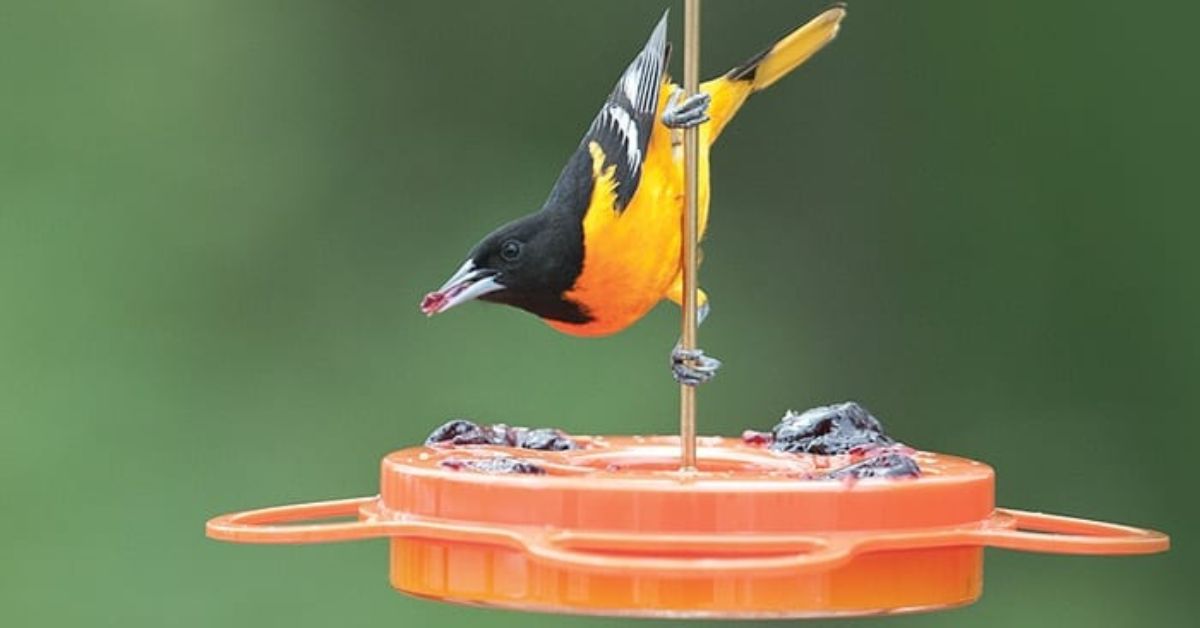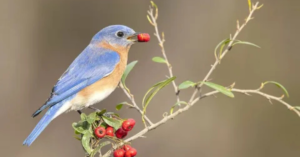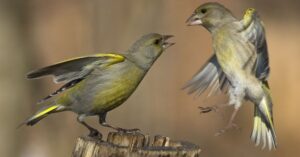Oriole feeders are a delightful way to attract these vibrant, melodious birds to your yard. Known for their striking orange and black plumage, orioles are drawn to specific feeders designed to offer their favorite treats, like nectar, fruits, and jelly. Setting up an oriole feeder not only provides a reliable food source for these birds but also gives you a front-row seat to their fascinating behavior and beauty.
1. What Are Oriole Feeders?
1.1 Why Orioles Need Special Feeders
Oriole feeders are specifically designed feeding stations that cater to the unique dietary needs of orioles, vibrant songbirds known for their striking plumage and melodic calls. Oriole feeders often feature bright colors—especially orange—to attract these birds, who are naturally drawn to such hues.
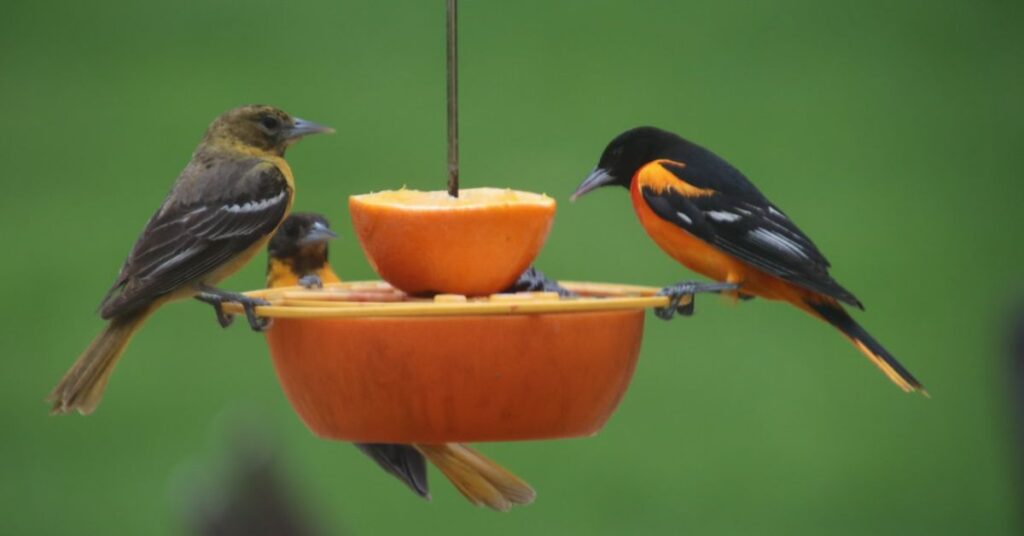
They typically have multiple feeding ports and reservoirs for nectar, fruit, or jelly, which are essential components of an oriole’s diet.
Orioles require special feeders primarily because of their feeding habits and preferences. These birds have a long, slender bill adapted for sipping nectar from flowers, making traditional seed feeders inadequate for their needs.
Orioles are fond of sweet treats like sugar water or fruit, which can be easily dispensed through the design of a dedicated feeder. Without these tailored options, it’s challenging to attract them to your garden.
1.2 How Oriole Feeders Differ From Hummingbird Feeders
While both oriole and hummingbird feeders serve the purpose of attracting nectar-loving birds, their designs cater to the distinct feeding habits of each species. The best Hummingbird feeders generally have smaller openings to accommodate the tiny beaks of hummingbirds, whereas oriole feeders feature wider ports that allow orioles to feed comfortably.
2. Types Of Oriole Feeders
2.1 Nectar Feeders: A Sweet Treat For Orioles
Nectar feeders are a delightful way to attract orioles, offering these vibrant birds a sweet treat that mimics their natural diet. Designed specifically for their feeding habits, these feeders often feature bright colors—especially orange and yellow—which are known to catch the attention of orioles.
2.2 Jelly Feeders: Why Orioles Love Grape Jelly
Jelly feeders are a favorite among orioles, particularly because these vibrant birds have a sweet tooth that craves sugary delights. Grape jelly, in particular, stands out as a top choice due to its rich flavor and high sugar content, mimicking the natural sweetness of ripe fruits that orioles would typically forage for in their habitats.
When setting up a jelly feeder, consider using a shallow dish or a specialized feeder with ports designed for orioles. This not only helps prevent the jelly from becoming contaminated but also allows multiple birds to feed at once, creating a lively scene.
By placing the feeder near flowering plants or fruit-bearing trees, you can attract even more orioles, as they will be drawn to the combination of sweet treats and potential nesting sites.
2.3 Fruit Feeders: Attracting Orioles With Fresh Citrus
Fruit feeders are a delightful way to attract orioles, particularly when they feature fresh citrus fruits like oranges and grapefruits. Orioles have a natural affinity for these bright, sweet fruits, which not only provide essential nutrients but also stimulate their vibrant colors.
By slicing the fruit in half and securing it to a feeder or hanging it from a tree branch, you create an inviting snack bar that encourages these beautiful birds to visit your yard. Remember to change the fruit regularly to ensure freshness and prevent spoilage, which can deter birds from returning.
3. Setting Up An Oriole Feeder
3.1 Choosing The Best Location
When selecting the ideal location for your oriole feeder, consider both visibility and accessibility. Orioles are drawn to open spaces where they can easily spot food sources while remaining vigilant against predators. Position your feeder near a natural perching area, such as trees or tall shrubs, which provides the birds with a safe vantage point to survey their surroundings.
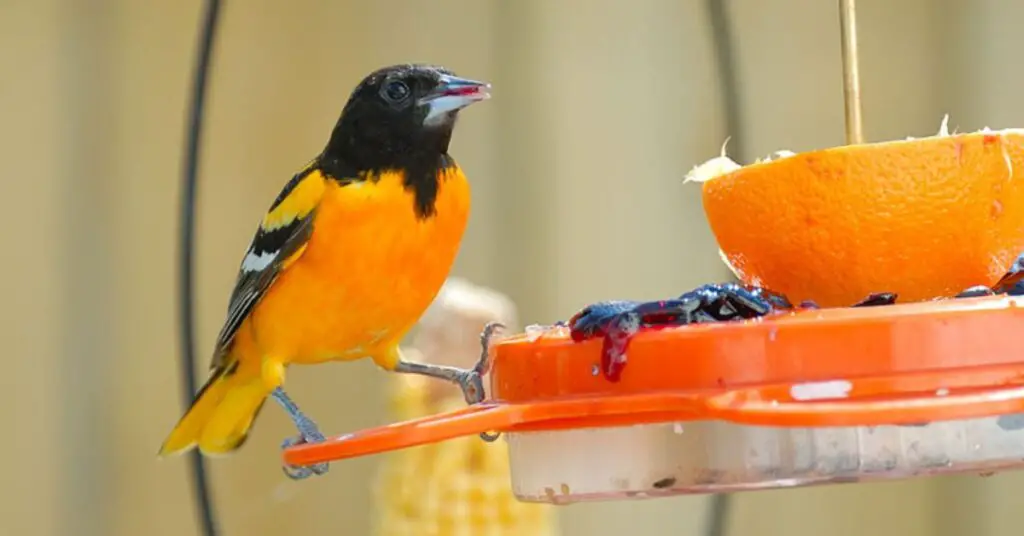
Ensure that the feeder is placed away from direct sunlight for extended periods, as extreme heat can spoil the nectar. A shaded spot will help maintain the nectar’s freshness and encourage more frequent visits. Avoid placing the feeder too close to windows, as collisions can be fatal for these beautiful birds.
3.2 Properly Hanging And Securing The Feeder
To hang and secure your oriole feeder, the location is key to attracting these vibrant birds. Choose a spot that offers a good view of your yard but is also sheltered from strong winds and direct sunlight. Place the feeder about 5 to 10 feet off the ground, allowing orioles to feel safe while also being easily visible.
Once you’ve found the right spot, ensure that the feeder is securely hung to prevent it from swaying or tipping over. Use sturdy hooks or brackets designed for bird feeders, as they provide stability and can support the weight of the feeder even in windy conditions.
3.3 Tips For Keeping Other Birds And Pests Away
To ensure your oriole feeder attracts its intended guests while keeping unwanted birds and pests at bay, consider strategic placement and feeder design. Position your feeder at least 10-15 feet away from trees or structures where other birds might perch and swoop down to steal the food.
Using a feeder designed with bee guards or ant moats can help deter these pesky insects from invading your oriole feast.
Another effective strategy is to choose foods that specifically attract orioles while discouraging other species.
4. What To Feed Orioles: A Guide To Their Diet
4.1 Homemade Nectar Recipes
To feed orioles, homemade nectar is a delightful and effective option that can attract these vibrant birds to your backyard. A simple yet rewarding recipe involves mixing four parts water with one part white granulated sugar. Heat the mixture gently until the sugar dissolves completely, then allow it to cool before filling your feeders.
4.2 Best Fruits To Offer (Oranges, Apples, And More)
Oranges are a top choice due to their vibrant color and high sugar content, which appeals to these birds’ sweet tooth. Halving an orange and securing it on a feeder or tree branch not only provides a feast but also adds a splash of color to your garden. The juicy flesh of the orange helps keep orioles hydrated, especially during hot summer months.
Apples are another excellent option, but they require a bit of preparation. Slicing them into smaller pieces can entice orioles to visit your feeders. Consider using sweeter varieties like Fuji or Gala for maximum attraction. Other fruits such as grapes, berries, and even melons can also be offered, as they provide essential nutrients and variety in their diet.
4.3 Is Store-Bought Jelly Safe For Orioles?
When considering what to feed orioles, many bird enthusiasts often reach for store-bought jelly as a convenient option. While these products can be appealing due to their bright colors and sweet aromas, it’s crucial to scrutinize the ingredients.
Many commercial jellies contain high fructose corn syrup and artificial preservatives, which may not only be unhealthy for orioles but could also disrupt their natural feeding habits.
5. When To Put Out Oriole Feeders
5.1 Seasonal Timing: Spring And Early Summer
To attract orioles effectively, timing your feeder placement is crucial. Spring marks the beginning of their migration back to North America, typically around mid to late March, depending on your geographic location.
Setting out your oriole feeders by early April can significantly increase your chances of spotting these striking birds in your yard as they arrive in search of sustenance. Early summer is equally important for oriole feeding, as it coincides with nesting season. During this time, orioles need a steady supply of food to feed their young.
5.2 Regional Variations Across The USA
The timing for putting out oriole feeders can vary significantly across the United States, influenced by regional climates and the migratory patterns of these vibrant birds. In the southeastern states, such as Florida and Georgia, orioles often arrive as early as mid-March.
In northern regions like Michigan and New York, the migration peaks around late April to early May. This means that bird lovers in these areas should wait until mid-April to put out their feeders, allowing them to align with the birds’ natural arrival times.
6. How To Attract Orioles To Your Feeder
6.1 Bright Colors: Why Orange Is The Magic Hue
To attract orioles to your feeder, the color orange is nothing short of a beacon. These vibrant birds are naturally drawn to bright hues, and orange resonates particularly well with them. This attraction is not merely aesthetic; it stems from their instinctual connection to ripe fruits like oranges and berries, which are staple foods in their diet.
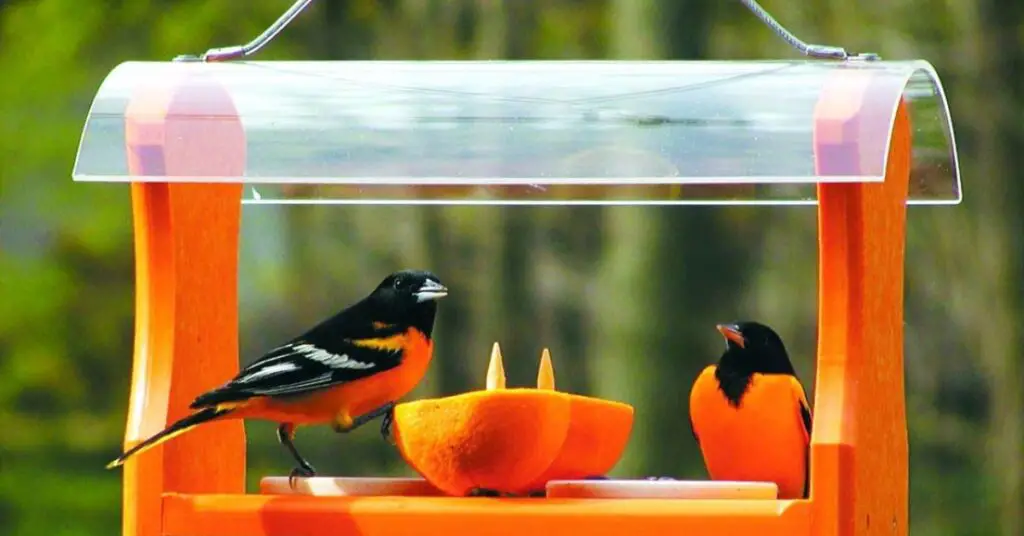
6.2 Mimicking Natural Habitats In Your Backyard
To attract orioles to your feeder, it’s essential to create an environment that mimics their natural habitats. These vibrant birds thrive in areas abundant with fruit-bearing trees and flowering plants. Consider planting native species such as dogwoods, mulberries, or serviceberries, which not only provide sustenance but also offer shelter.
Incorporating a variety of nectar-rich flowers, like trumpet vine or bee balm, can draw orioles in with their bright colors and sweet scents, encouraging these avian visitors to linger longer in your garden.
6.3 Adding Water Sources For Extra Appeal
These vibrant birds are not only drawn to feeders filled with their favorite foods, but they also seek out reliable hydration options. A shallow birdbath or a decorative fountain can serve as an enticing oasis, offering both drinking water and a place to splash around.
Adding movement to your water feature can increase its allure even further. Birds are naturally attracted to the sound and motion of flowing water, which can mimic their natural habitat. Whether it’s a small recirculating fountain or a dripping system, these elements can create a delightful ambiance that beckons orioles to your yard.
Keeping the water fresh and clean is crucial; regularly changing the water not only prevents algae buildup but also ensures that it remains a safe and appealing spot for these feathered visitors.
7. Maintaining Your Oriole Feeder
7.1 Cleaning Tips To Prevent Mold And Disease
To ensure the health of your visiting orioles, regular cleaning of your feeder is essential. Mold can develop quickly in sugary solutions, creating a breeding ground for harmful bacteria. A simple yet effective cleaning routine involves disassembling the feeder and soaking it in a solution of warm water and white vinegar or mild soap.
Scrubbing with a bottle brush can reach those tricky corners where residue tends to hide. Rinsing thoroughly ensures no cleaning agents remain, which could deter birds or harm their delicate systems.
7.2 How Often To Refill Nectar And Jelly
To ensure your oriole feeder remains a reliable source of nourishment, it’s essential to establish a consistent refilling routine for both nectar and jelly. Nectar should be replenished every 3 to 5 days, especially during peak feeding times in spring and summer.
Jelly, tends to attract orioles quickly due to its sweetness and rich flavor. It’s best to refill jelly every 2 to 4 days, depending on how rapidly it disappears. Keep an eye on the consistency; if it starts to dry out or develop a crust, it’s time for a change.
7.3 Inspecting For Damage Or Wear
Regularly inspecting your oriole feeder for damage or wear is essential to ensure a safe and welcoming environment for these beautiful birds. Start by examining the feeder’s structure—look for cracks, chips, or rust that could compromise its integrity.
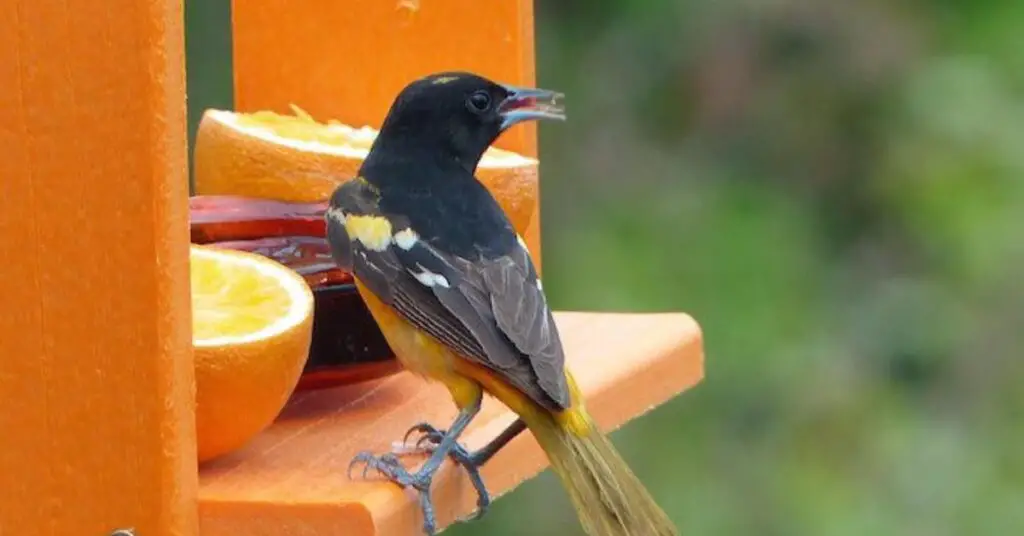
Small fissures can lead to leaks in the nectar, while rust may introduce harmful substances into the food source. If you notice any significant wear, it may be time to consider a replacement, as an intact feeder not only attracts orioles but also supports their health.
Conclusion
Providing oriole feeders in your backyard can significantly enhance your birdwatching experience while supporting local wildlife. These birds are attracted to specific food sources, such as nectar and fruits, making it essential to choose the right feeder and food combination. Regular maintenance of the feeders will ensure that they remain inviting and safe for the orioles.
FAQ’s
Can You Use A Hummingbird Feeder For Orioles?
Yes, you can use a hummingbird feeder for orioles, but there are some important considerations to keep in mind. While both birds enjoy sweet nectar, orioles typically prefer a different sugar-to-water ratio compared to hummingbirds.
What Is The Best Time Of Day To Spot Orioles?
The best time of day to spot orioles is typically during the early morning hours, just after sunrise, and late afternoon, leading into dusk.
How Do You Keep An Oriole Feeder Ant-Free?
Consider using a feeder designed with an ant moat. This feature is essentially a small reservoir that you fill with water, creating a barrier that ants cannot cross. By placing the feeder on a pole or hook with the ant moat positioned above it, you can effectively prevent ants from reaching the nectar.
- Female Eastern Bluebirds - March 25, 2025
- Keep Ants Away From Hummingbird Feeders - March 25, 2025
- A Guide To Oriole Feeders - March 25, 2025
